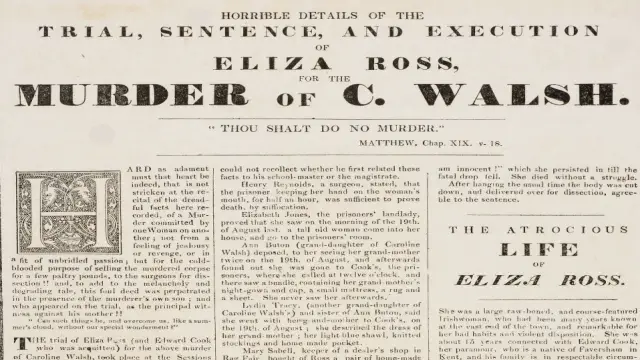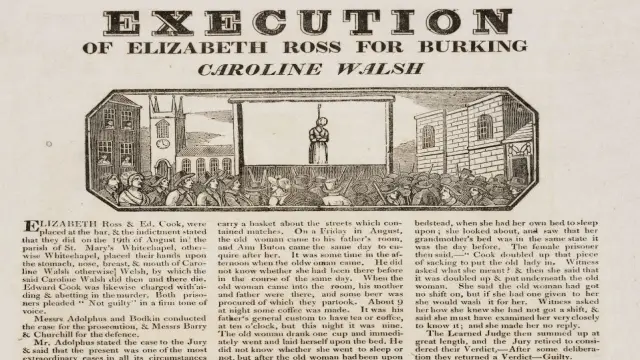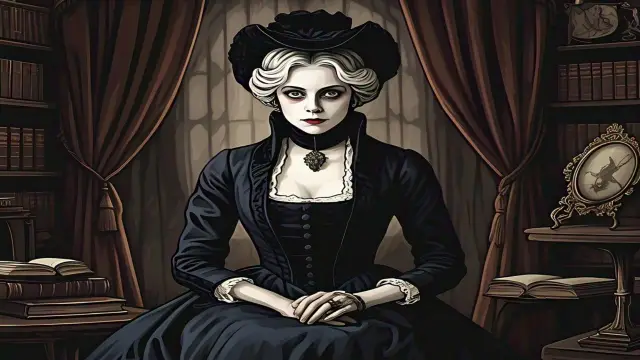The Dark Tale of Elizabeth Ross: A Murder in Regency London
In November 1831, as Bishop, Williams, and May stood trial for the infamous murder of Carlo Ferrier, another sinister case unfolded. This time, it involved Elizabeth Ross, a gin-soaked woman from Goodman’s Yard, accused of murdering her elderly neighbor, Caroline Walsh. What made this case even more shocking was that Ross became the first—and only—woman executed for “Burking” in London’s history.
The Disappearance of Caroline Walsh
Caroline Walsh was an 84-year-old street vendor who sold threads, bobbins, and stay-laces to scrape together a meager living. She lived at No. 2 Red Lion Square with her granddaughter, Ann Buton. Their neighbors were Edward Cook and his common-law wife, Elizabeth Ross, who had recently moved to nearby Goodman’s Yard (marked in red on historical maps).
Ross and Cook tried hard to persuade Mrs. Walsh to move in with them. However, the frail old woman resisted, preferring her current lodgings. Eventually, Ross wore her down, and on August 19th, 1831, Mrs. Walsh went to live with the Cooks at No. 7 Goodman’s Yard. That was the last time anyone saw her alive.
Ann Buton grew suspicious when she didn’t see her grandmother after August 19th. She visited Goodman’s Yard to inquire about Mrs. Walsh but received vague answers from Ross. When pressed further, Ross replied defensively, “You seem to think we have murdered the woman.” These words planted seeds of doubt in Buton’s mind.

A Web of Lies Unravels
As days passed, Buton searched tirelessly for her grandmother. She visited poorhouses, hospitals, and prisons but found no trace of Mrs. Walsh. Meanwhile, Ross continued to spin lies, claiming the old lady had simply gone out or moved elsewhere. Her behavior became increasingly erratic, especially when she begged Buton for money to buy gin—a drink she refused to replace with beer during a visit to Brown’s pub.
Buton’s suspicions deepened when she returned to the Cooks’ room one evening and found Edward Cook bruised and angry after beating Ross for getting drunk. Despite repeated questions, neither Cook nor Ross could explain where Mrs. Walsh had gone. Finally, unable to bear the uncertainty, Buton reported her grandmother’s disappearance to Lambeth Street Police Station.
The Investigation Begins
Officer James Lea took charge of the case. On October 28th, he accompanied Buton to Goodman’s Yard, where they confronted Elizabeth Ross. She claimed Mrs. Walsh had left their home early the next morning after spending a pleasant evening with the family. However, discrepancies emerged when Lea questioned Edward Cook. While Ross said they’d eaten cold meat and coffee before retiring at nine o’clock, Cook insisted they’d had tea and hot meat and gone to bed at eleven fifteen.
These contradictions led to the arrest of both Ross and Cook. Lea also detained their twelve-year-old son, Ned, whose testimony would prove pivotal in court.
Ned Cook’s Shocking Testimony
At the Old Bailey trial on January 6th, 1832, Ned Cook became the prosecution’s star witness. He recounted how, on the night Mrs. Walsh disappeared, he heard his mother get up in the middle of the night. From his bed, he saw her press her hands against the old woman’s face and chest, suffocating her for nearly half an hour while his father stood silently by the window.
Later, Ned witnessed his mother carry Mrs. Walsh’s body downstairs and place it in a sack in the cellar. When he returned home from school the next day, his father was beating his mother for drinking with a young woman. That evening, Ned watched through the window as his mother carried the sack into the street.
Elizabeth Ross sobbed in court, crying, “Good God! How could I have borne a son to hang me!” But Ned tearfully insisted he was telling the truth.
Evidence Against Elizabeth Ross
Further damning evidence came from rag buyers at Rosemary Lane’s Rag Fair (marked in blue on historical maps). They testified that Ross had sold them several items of clothing belonging to Mrs. Walsh. When these garments were presented in court, Buton and her sister Lydia Basey confirmed they recognized them as their grandmother’s possessions—some even handmade by Buton herself.
The defense argued that Mrs. Walsh had been seen at Tibble’s Poor House and died there later. However, descriptions of the deceased did not match Mrs. Walsh. The jury deliberated briefly before delivering a guilty verdict for Ross and acquitting Cook.
Execution and Legacy

On January 9th, 1832, Elizabeth Ross met her fate at Newgate Prison. She was hanged outside the Debtor’s Gate, becoming the first—and only—woman executed for “Burking,” a method of murder involving suffocation without leaving visible marks. Afterward, her body was handed over to anatomists for dissection.
Dr. William Clift, an anatomist, sketched Ross post-mortem. His drawing revealed a gaunt, weathered face far older than her thirty-eight years—a testament to years of gin-soaked debauchery in the slums of Regency London.
What Was Burking?
“Burking” gained notoriety following the Burke and Hare murders in Edinburgh, where victims were smothered to avoid detection. It became a feared term in 19th-century Britain, synonymous with stealthy killings committed for profit. In Ross’s case, the motive likely stemmed from greed, as evidenced by the stolen clothes sold to rag dealers.
A Grim Chapter in London’s History
Elizabeth Ross’s story is a chilling reminder of the dangers lurking in 19th-century London’s impoverished neighborhoods. Just decades later, the same area—Whitechapel—would become infamous for Jack the Ripper’s reign of terror.
Ross’s execution marked the end of a dark chapter but highlighted societal issues like poverty, addiction, and desperation that plagued Victorian England. Her legacy lives on as a cautionary tale of how greed and moral decay can lead to unspeakable acts.
Conclusion
The case of Elizabeth Ross remains one of the most disturbing episodes in London’s criminal history. As the first woman convicted of “Burking,” she symbolizes the brutal realities of life in Regency-era slums. Her story serves as both a historical footnote and a stark warning about the consequences of unchecked ambition and depravity.
Would you dare explore Goodman’s Yard today, knowing its grim past? Let us know your thoughts in the comments below!

